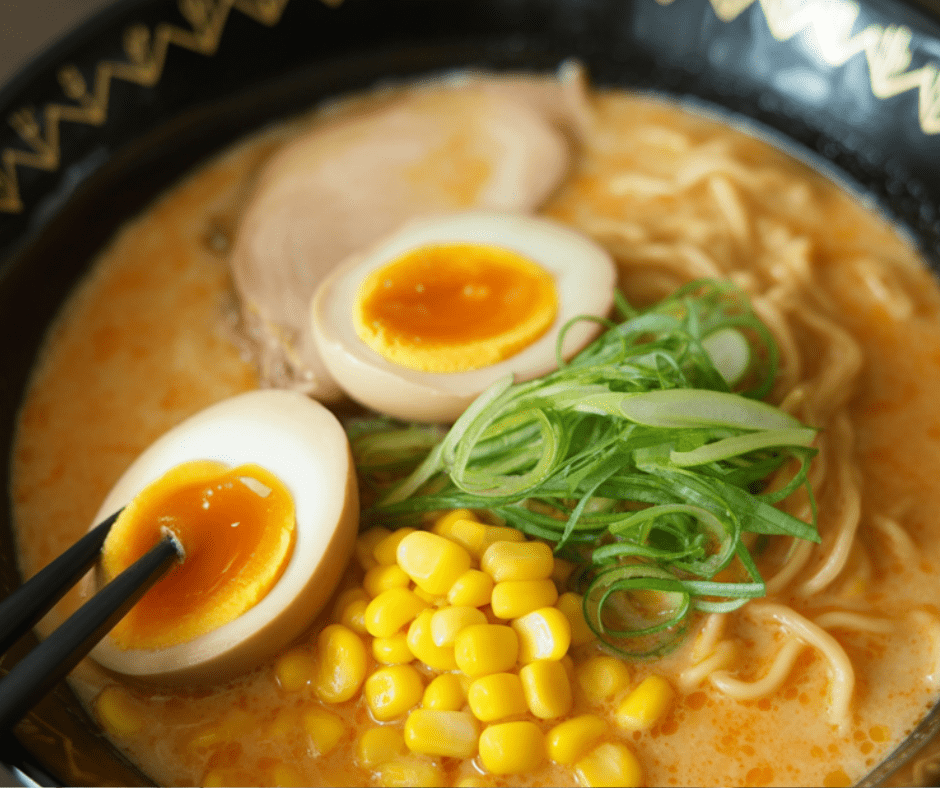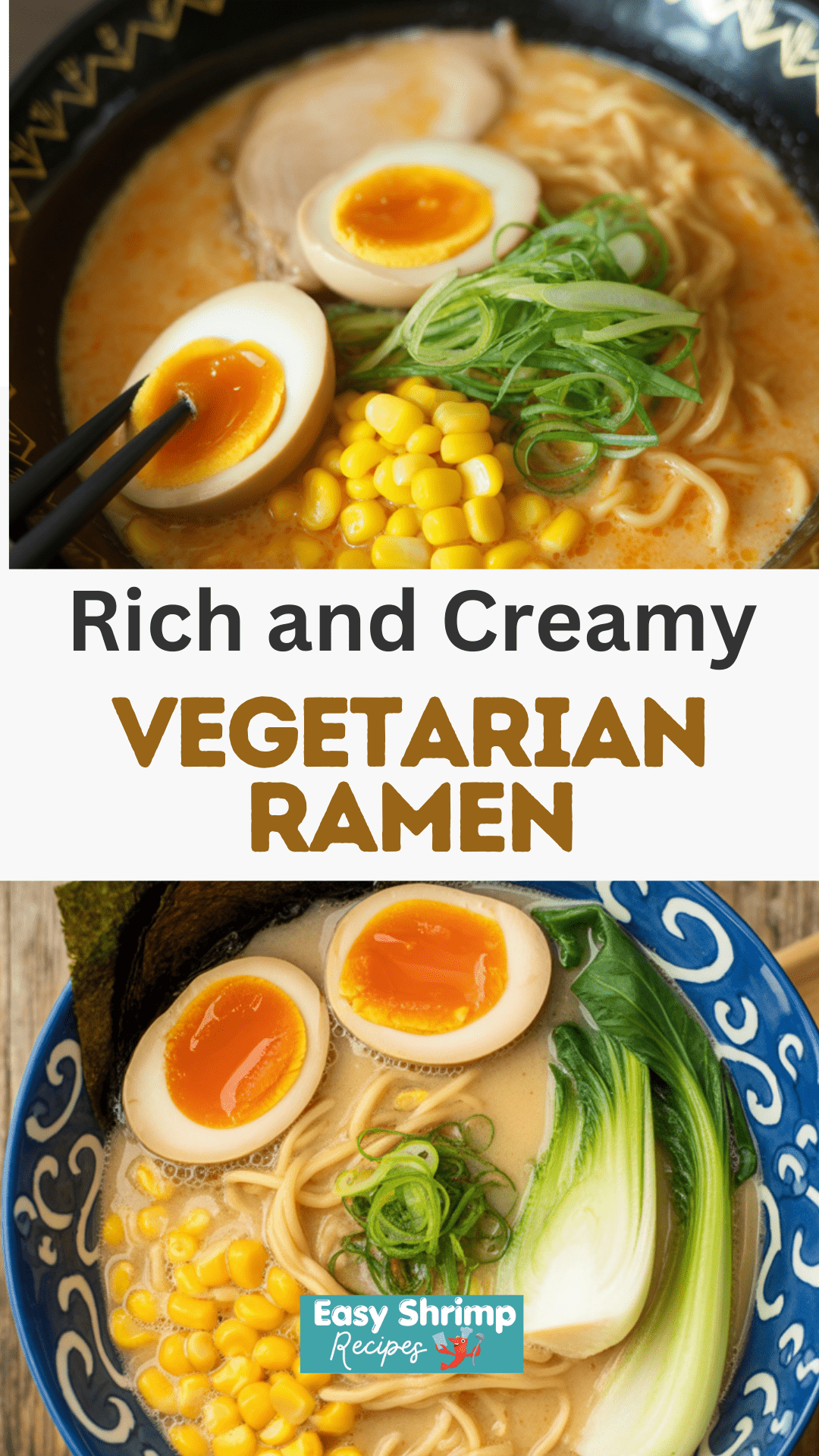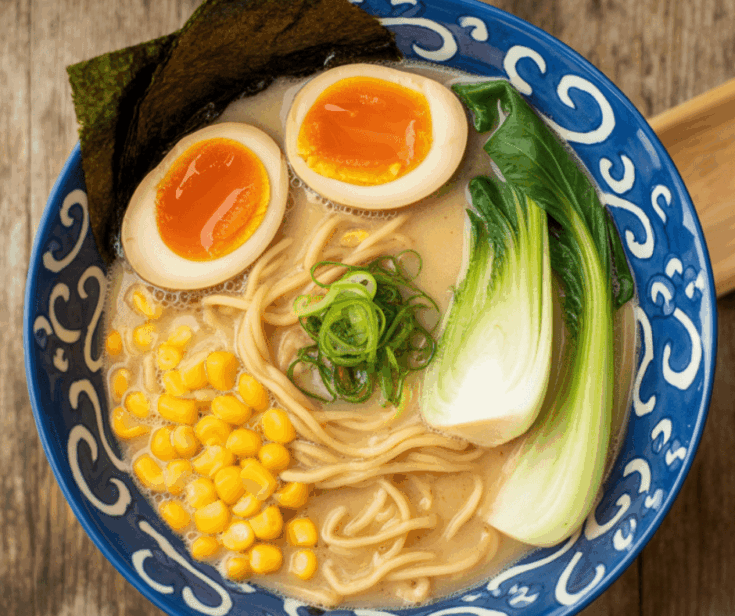If you’ve ever wondered whether a meatless ramen could still be rich, creamy, and full of deep flavor, this soy milk miso ramen will convince you in one slurp. This Vegetarian Ramen brings together nutty miso, earthy mushrooms, creamy soy milk, and a fiery little kick from chili bean paste. It’s fast enough for a weeknight but special enough to impress any ramen lover at your table.

Why You’ll Love This Recipe
- Velvety rich broth that feels like tonkotsu but is totally plant-based
- Ready in 30 minutes if you prep your dashi ahead
- Customizable toppings – keep it vegan or go big with a ramen egg
- No weird ingredients – just pantry staples and some easy-to-find Japanese seasonings
Key Ingredients for the Broth
This broth is where the magic happens. Let’s talk about the four must-haves that give this ramen its flavor and body:
- Unsweetened Soy Milk: Adds richness and that signature creamy texture. It’s important to use plain, unsweetened soy milk—no vanilla or sweetened versions here.
- Vegan Dashi: Made from kombu (dried kelp) and dried shiitake mushrooms. This plant-based stock delivers deep, savory umami. If you’re not vegetarian, feel free to swap in chicken stock or traditional dashi.
- Miso Paste: Awase miso (a mix of red and white miso) or Koji miso both work beautifully here. Miso gives body, flavor, and that lovely fermented note that makes ramen taste like ramen.
- Chili Bean Paste: Just a little of this spicy fermented paste goes a long way. It adds heat, saltiness, and serious depth. If you’re cooking for kids or don’t love spice, go for a mild version or skip it entirely.
What You’ll Need
- Aromatics: Garlic, ginger, scallions
- Condiments: Soy sauce, sake, white pepper, sesame oil
- Base: Kombu, dried shiitake, soy milk, miso, doubanjiang
- Noodles: Fresh or dried ramen noodles (check labels for vegan-friendly options)
- Toppings (all optional): Ramen eggs, corn, scallions, bok choy, spicy bean sprouts, kimchi, seaweed, tofu, edamame

How to Make It
Make the Dashi
Let kombu and dried shiitake soak in water for at least 30 minutes—or overnight in the fridge. Then bring it almost to a boil, remove the solids, and your vegan dashi is ready.
Sauté the Aromatics
In a saucepan, heat some sesame oil and sauté garlic, ginger, and scallions until fragrant. Stir in doubanjiang and miso, then deglaze with sake and soy sauce.
Build the Broth
Pour in the dashi and soy milk. Let everything simmer gently—don’t boil!—so the soy milk doesn’t curdle. Season with white pepper and a pinch of salt.
Prepare Noodles + Toppings
Cook ramen noodles according to package instructions. Blanch your veggies, warm up your corn, or prep any other toppings while the broth simmers.
Assemble Your Bowl
Divide the noodles between bowls, ladle the broth over them, and add your favorite toppings. Finish with a sprinkle of sesame seeds or a drizzle of chili oil if you like it spicy.
Tips & Variations
- No soy milk? Oat milk or cashew milk can work in a pinch, but make sure they’re unsweetened and unflavored.
- Want extra protein? Add cubes of fried tofu or a jammy ramen egg.
- Don’t overboil the broth after adding soy milk—it can split! Gentle simmer only.
- Spicy or mild: Adjust the doubanjiang to your taste. Start small—you can always add more.
Make It a Meal
Serve this ramen with:
- Spicy Edamame or Pickled Veggies
- Vegetable Gyoza or Tofu Skewers
- A cold glass of barley tea or crisp Japanese beer
Storage Notes
- Fridge: The broth keeps well for 3 days in an airtight container.
- Freezer: You can freeze just the broth (without soy milk). Add the soy milk when reheating.
- Leftovers: Reheat gently to avoid splitting the broth. Best to cook noodles fresh each time.

FAQ
Is this vegan?
Yes—just skip the ramen egg and make sure your noodles don’t contain egg.
Can I use store-bought broth?
You can, but homemade dashi really makes a difference. If you must, go for a low-sodium vegetable broth and add dried mushrooms while it simmers.
What can I substitute for doubanjiang?
Try gochujang for heat or doenjang for umami. Both are Korean pastes that work in a pinch, but the flavor won’t be exactly the same.
Vegetarian Ramen

This Vegetarian Ramen will completely change how you see meatless noodle bowls.
Ingredients
For the Vegan Dashi
- 1 cup water
- 1 cup water
- 1 piece kombu (5g; 2 x 2 inches)
- 1 piece kombu (5g; 2 x 2 inches)
- 1–2 dried shiitake mushrooms (3–5g each)
- 1–2 dried shiitake mushrooms (3–5g each)
For the Soup Broth
- 2 tablespoons toasted white sesame seeds
- 2 tablespoons toasted white sesame seeds
- 2 green onions/scallions (green parts reserved for garnish)
- 2 green onions/scallions (green parts reserved for garnish)
- 1 tablespoon toasted sesame oil
- 1 tablespoon toasted sesame oil
- 1½ teaspoons grated ginger
- 1½ teaspoons grated ginger
- 2 cloves garlic, minced
- 2 cloves garlic, minced
- 1½ tablespoons doubanjiang (spicy or mild chili bean paste)
- 1½ tablespoons doubanjiang (spicy or mild chili bean paste)
- 1½ tablespoons miso (avoid Saikyo and Hatcho types)
- 1½ tablespoons miso (avoid Saikyo and Hatcho types)
- ½ teaspoon kosher salt (Diamond Crystal preferred)
- ½ teaspoon kosher salt (Diamond Crystal preferred)
- 1 dash white pepper powder
- 1 dash white pepper powder
- 1 dash white pepper powder
- 1 tablespoon sake
- 1 tablespoon sake
- 1 tablespoon sake
- 1½ tablespoons soy sauce (or gluten-free version)
- 1½ tablespoons soy sauce (or gluten-free version)
- 1½ tablespoons soy sauce (or gluten-free version)
- 2 cups unsweetened soy milk
- 2 cups unsweetened soy milk
- 2 cups unsweetened soy milk
- 1 cup Vegan Dashi
- 1 cup Vegan Dashi
- 1 cup Vegan Dashi
For the Ramen
- 2 servings fresh ramen noodles (10–12 oz fresh or 6.3 oz dry)
- 2 servings fresh ramen noodles (10–12 oz fresh or 6.3 oz dry)
- 2 servings fresh ramen noodles (10–12 oz fresh or 6.3 oz dry)
- 1 large head Shanghai bok choy, quartered lengthwise
- 1 large head Shanghai bok choy, quartered lengthwise
- 1 large head Shanghai bok choy, quartered lengthwise
- Toppings of your choice (ramen egg, corn, nori, vegan kimchi, spicy bean sprouts)
- Toppings of your choice (ramen egg, corn, nori, vegan kimchi, spicy bean sprouts)
- Toppings of your choice (ramen egg, corn, nori, vegan kimchi, spicy bean sprouts)
Instructions
Make the Vegan Dashi
- Add kombu and shiitake mushrooms to 1 cup water and let soak for at least 30 minutes. Use a small weight or bowl to keep mushrooms submerged.
- After soaking, transfer the water, kombu, and mushrooms to a saucepan and bring to just below a boil over low heat.
- Remove the kombu and mushrooms before the water boils to prevent bitterness. Turn off the heat and measure to confirm you still have 1 cup of dashi—top off with water if needed.
Prepare Ingredients
- While the dashi soaks, prep everything else. Toast and crush the sesame seeds in a mortar and pestle.
- Grate the ginger, mince the garlic, and separate green onion whites and greens (slice both thinly). Rinse bok choy well and set aside.
Make the Soup Broth
- Heat sesame oil in a small saucepan over medium-low. Add garlic, ginger, and sliced white scallions, cooking until fragrant. Stir in doubanjiang and miso and cook for 1 minute, stirring constantly.
- Add sake and deglaze the bottom of the pan, then stir in crushed sesame seeds and soy sauce. Gradually whisk in soy milk and Vegan Dashi until smooth. Add salt and white pepper, then turn off heat, cover, and set aside.
Blanch the Bok Choy
- Bring a large pot of water to a boil. Add bok choy stem-side first and cook for 2 minutes.
- Remove and transfer to a bowl of cold water to stop cooking. Once cool, squeeze out excess water and set aside.
Cook the Noodles
- Reheat the soup broth until hot but not boiling. Loosen fresh noodles with your hands before cooking.
- Add to the boiling water and cook according to package instructions. Stir with chopsticks to separate. Drain thoroughly to prevent diluting the broth, then divide between two bowls.
Assemble and Serve
- Ladle hot broth over the noodles. Arrange bok choy and your favorite toppings on top—ramen egg (omit for vegan), corn, nori, kimchi, and spicy bean sprouts are all excellent choices. Garnish with chopped green onions and serve immediately.
Notes
- Broth can be kept in the fridge for up to 3 days. Cook noodles fresh right before serving to keep texture ideal.
Nutrition Information
Yield
2Serving Size
1Amount Per Serving Calories 1240Total Fat 52gSaturated Fat 16gTrans Fat 0gUnsaturated Fat 32gCholesterol 208mgSodium 5890mgCarbohydrates 142gFiber 15gSugar 13gProtein 54g
Easy Shrimp Recipes.com, occasionally offers nutritional information for recipes contained on this site. This information is provided as a courtesy and is an estimate only. This information comes from online calculators. Although allchickenrecipes.com attempts to provide accurate nutritional information, these figures are only estimates.

